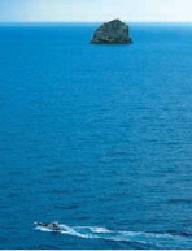Travel Reference
In-Depth Information
name, but the term for the overall group and the name for the largest and longest of them is
Hatenohama (
ハテの浜
). The words quite logically translate as “Beach at the End,” and surely
that's what it is, a beach at the end of Kume's east coast running straight back towards Ok-
inawa.
There are no dwellings, hotels or buildings of any kind. It's uninhabited and uninhabit-
able. During the summer months a port-asan type toilet is brought out and parked on the
beach. Enterprising Kume residents sometimes bring out beach umbrellas to rent as there is
no shade.
Solitary Tonbara Rock stands sentinel at the southernmost tip of Kume Island.
Hateno Beach is reachable by private boat. All the hotels on Kume have connections with
operators who offer day excursions out to the islets. The water at Hatenohama is amazingly
clear and warm, partly because it is so shallow. Glass-bottom boat tours also go out. If you
like long strolls along the beach, this is a good place. Bring cold drinks, fresh water and sun-
screen lotion with you! If you fly out to Kume, you'll almost always get a good view of Haten-
ohama from the air as you approach the island.
TONBARAIWA
(
トンバーラ岩
; Tonbāra iwa). Roughly three-quarters of a mile (1 kilometer)
of the southernmost tip of Kume Island lies this solid bastion of stone (page
185
). It stands
isolated and alone, a silent sentinel for what cause or claim, who knows? The rock measures
approximately 820 feet (250 meters) in diameter and about 660 feet (200 meters) high. It sup-
ports a bit of green vegetation at its top. There's really not too much to say about it other than
it's impressive in its own commanding way. Surely there are some birds or other creatures liv-
ing on this place, but it's more than certain that it's not inhabitable by man.

